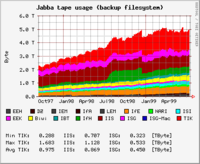
Photo from wikipedia
In network function virtualization (NFV), network function implemented in software on the generally shared servers is called virtualized network function (VNF). The characteristics of virtualization provide service function chain (SFC)… Click to show full abstract
In network function virtualization (NFV), network function implemented in software on the generally shared servers is called virtualized network function (VNF). The characteristics of virtualization provide service function chain (SFC) provisioning with the required flexibility by allowing for placing VNFs anywhere and anytime. However, there may be a large number of servers with low utilization across the network at the low-load time, leading to enormous loss of energy. VNF consolidation, as an effective way to address this issue, allows for energy saving by consolidating VNFs into as fewer servers as possible. Unfortunately, it involves multiple conflicting goals, such as energy saving, bandwidth usage minimization, and migration cost reduction, which makes it hard to implement in practical environments. In order to achieve the tradeoff among these goals, this paper proposes a VNF consolidation method, VCMM, which determines appropriate servers to be turned off by leveraging neural network with multiple network status characteristics as input. The neural network is trained using the particle swarm optimization algorithm (PSO). VCMM migrates VNFs on servers to be turned off by adopting a greedy mechanism. Through extensive simulations, we demonstrate that the proposed VCMM outperforms prior approaches in terms of energy, bandwidth, and migration costs.
Journal Title: IEEE Access
Year Published: 2019
Link to full text (if available)
Share on Social Media: Sign Up to like & get
recommendations!